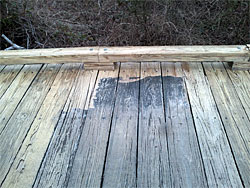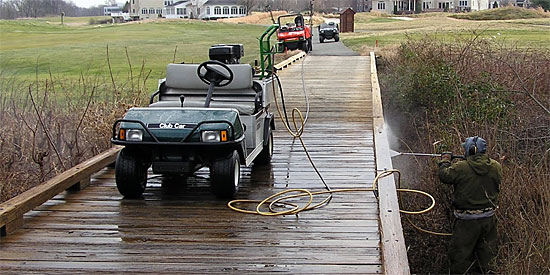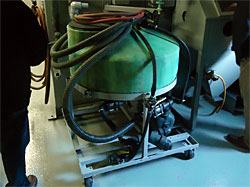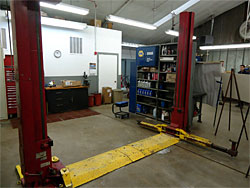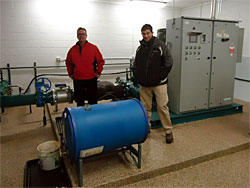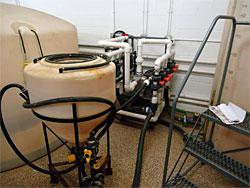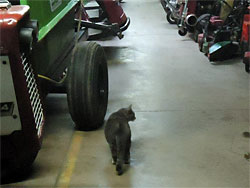|
 |
January 29, 2013 |
|
Soil Temperatures... Rick Tegtmeier, Des Moines Golf & Country Club, West Des Moines, IA:  "I used to think that once the soil was frozen the temperature of it would not change much. I thought freezing was freezing. A few years ago we installed some remote soil probes that monitor the soil, and it proved I was very wrong in my thoughts. Last year we saw very little fluctuation in the soil temperatures at the freezing mark because it did not get very cold at all. This year once the snow blanket had melted we started seeing the soil temperatures react to the ambient temperatures. As you can see in the following chart if the air warms up the soil follows suit, as it gets colder so does the soil. 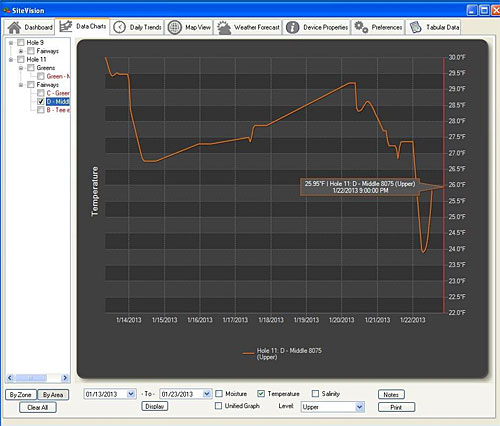 We really like seeing the frost get into soil and act as a natural way to break up the soil. This freezing and thawing helps to expand and contract the soil to help it loosen up and become more mellow in the spring. So, below freezing can mean a lot of different things to different people. For us, this winter it is a good thing to have the natural aerification at work to help our soils. Now some more precipitation would be a great thing!" |
 |
|
"Success Occurs When Opportunity Meets Preparation" Jeff Johnson, The Minikahda Club, Minneapolis, MN:  "People don't plan to fail, the just fail to plan."
There are many aspects that need to be considered when developing a strategy for each area of the golf course. As we enter the season I want to make sure we have a comprehensive plan and schedule in place, because even though we have a specific objective there are times we need to vary from the plan based on weather, growing conditions or changes to the golf calendar. By developing our applications now we know what products we expect to use, how much we estimate will be utilized and the cost associated with the implementation of the programs. When planning, I typically design the program for a worst case scenario with rates and frequency of use, ultimately being more than we will need to use that season.
Once each individual application is scheduled on the calendar, then the tedious task of developing each individual fertility and fungicide application begins. I utilize a program called SPaRKS Superintendent Version software (very inexpensive) that is tailored to golf course operations. Through this software I am able to develop each application in advance. Once all the data is entered, I can then use that information to make sure our expected fertility applications are at the rates we desire and within the budget we have been allocated. The software also allows us to print application sheets for each individual application, record the information as well as print reports that show us fertility rates, final product costs and usage. I can then utilize this information for future planning and ordering of product based on past years needs and requirements. |
 |
|
Under Pressure... John Slade, Laurel Creek Country Club, Mount Laurel, NJ:
 "Over the winter we are pressure washing the bridges on the golf course. This is a time-consuming job, with each bridge taking several days to complete. Since the irrigation system is shut down, a 300 gallon sprayer is filled at the maintenance facility, then used as the water source for the pressure washer.
Visit John's blog at laurelcreeksuper.blogspot.com. |
 |
|
Blog writing tips from the Maestro... Peter McCormick, TurfNet, Cornwall, VT:  "I read a lot of blog posts each week while selecting those to appear here in the Aggregator. Some posts are very good, some not so much.
I'll be back at some point with more." |
 |
|
New Year, New Opportunities... Brandon Collins, Country Club at Woodmore, Mitchellville, MD:  "Each winter, I write a post about how the management team in the Green Department sits down and evaluates the previous season. Like many other Superintendent's, we all take detailed notes throughout the playing season about what is working, what isn't, and what we could do better the next year. The majority of these notes are about agronomic practices, fertility and chemical schedules, and personnel management. No matter how good of a season we had in the previous year, we never fail to find many areas for improvement.
This year, we made a decision to take these meetings/brainstorming sessions one step further. Rather than just looking at the basic functions of our Department, we challenged ourselves to look at the Club operation as a whole. How could we, 'the grass cutters', have more of an impact on the success of our facility?
It is becoming increasingly common for women to make the financial decisions in a household. So we, along with the Pro Shop and help from several members, sought to find a way to set up the golf course that is more appealing to the average woman golfer.
Our first attempt involved putting temporary tees in mowed-down areas of the roughs. The goal was to make club selection for the women much closer to that of an average male golfer. For example, the majority of men will hit a 5-iron down to an 8-iron in to #1. From the forward tees, most women were having to hit a 3 wood on their second shot. We moved tee markers forward in an attempt to get women hitting their mid irons in to the green. The concept went over great with those who elected to play the temporary tees, but we still had logistical problems with the installation and maintenance of these tee boxes. Many were not in irrigated areas and adding a new tee box on every hole brings a significant amount of added cost to the maintenance budget.
It is important to stress that the spring will be a trial period for these areas. We will not be changing turf varieties, we will simply be reducing our mowing frequency as well as our chemical and fertilizer inputs. If we do find that we have an area or two that significantly slows play or looks out of place, we can always mow it down and regain the traditional look. If the overall feedback negative, we tried something and it didn't work. But, if the feedback is anywhere from neutral to positive, we will have reduced the overall cost of maintaining the rough by 20%. This includes shorter mowing time, reduced fuel consumption, as well as smaller quantities of chemicals and fertilizer. This will help to lessen our carbon footprint as well as improve the micro-environment that is our golf course. These 'no-mows' and lake bank buffers have been proven to reduce runoff of fertilizer in to surrounding bodies of water. Over time, we will see a reduction in the aquatic vegetation in the pond as a result of these areas." Visit Brandon's blog at http://ccwoodmoregcm.com. |
 |
|
Sightseeing... Shane Conroy, asst supt, Park Ridge Country Club, Park Ridge, IL:
 "Yesterday a few of us from PRCC were able to get out and visit some other local golf courses and get an in depth look at their maintenance facilities and practices. The three courses we visited were Westmoreland Country Club in Wilmette, Winnetka Golf Club in Winnetka and North Shore Country Club in Glenview. Each facility was very different and it was a great opportunity to see nearby shops and bounce ideas off of other industry leaders. Below are a few highlights of the tour.
Visit the Park Ridge blog at parkridgeccgrounds.blogspot.com. |
 |
 |
|
About our Blog Aggregator: Many superintendents are now hosting private blogs to better communicate with their golfers and/or members. Beyond local weather and course conditions, there is a great deal of information about projects, methodologies and techniques that would be of value to other superintendents — hence our Turf Blog Aggregator. As every blogger struggles occasionally with content, we also include posts intended to educate golfers about turf maintenance for others to use as a template for their own blogs. Miss any previous issues of TBA? You can find them all here. |
